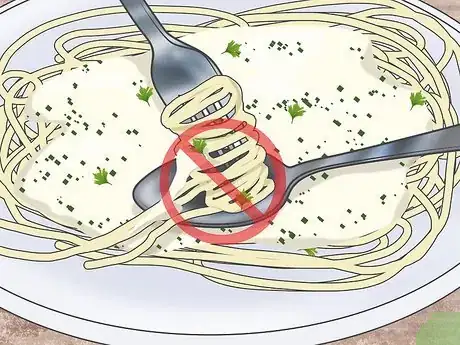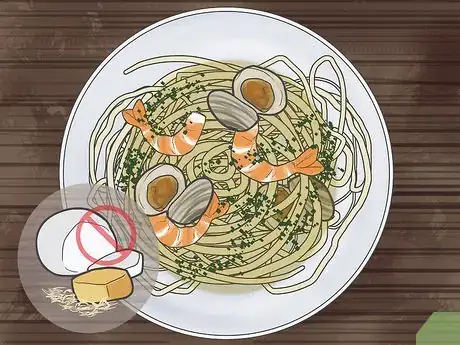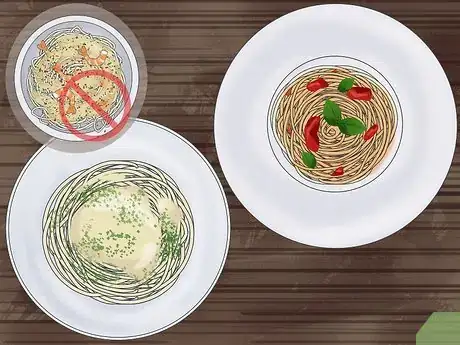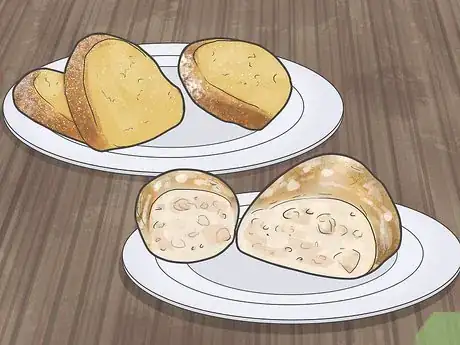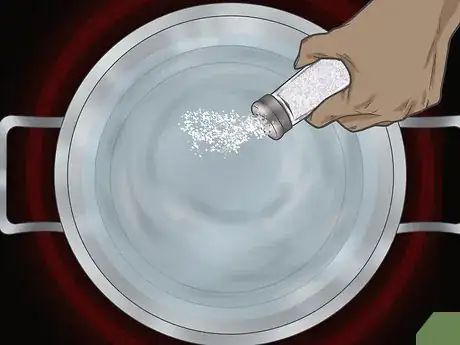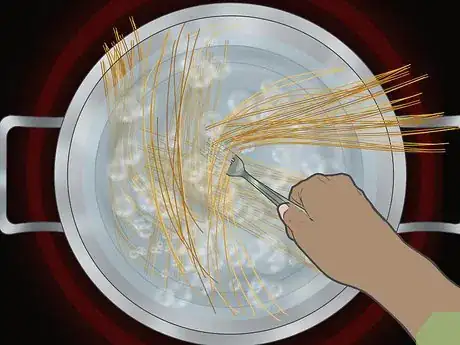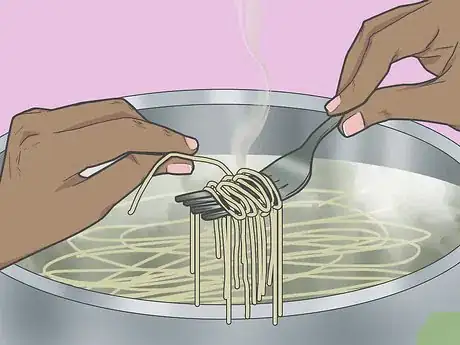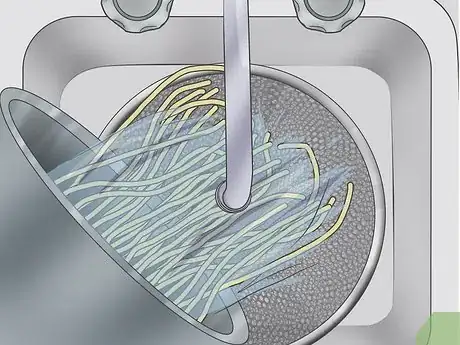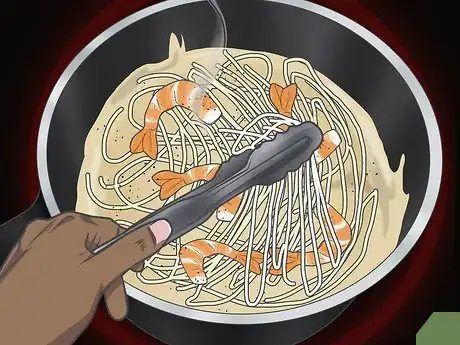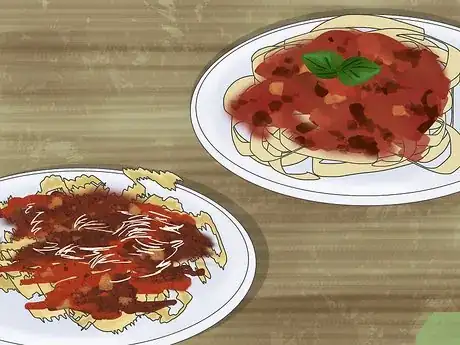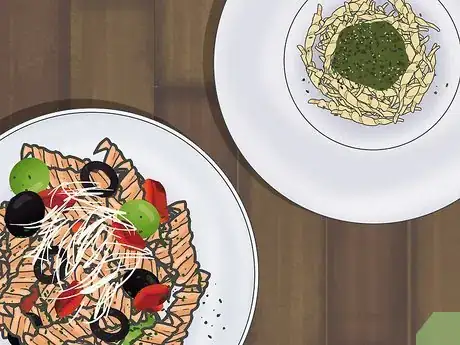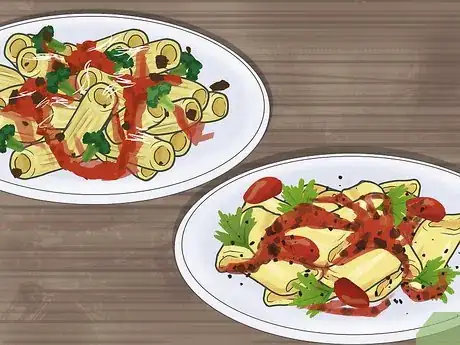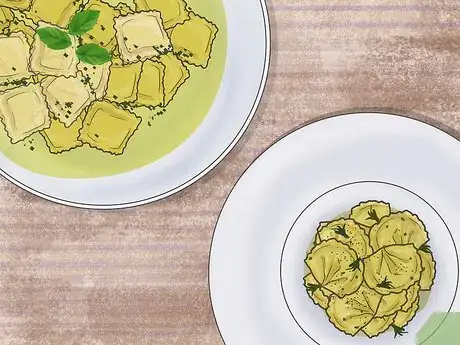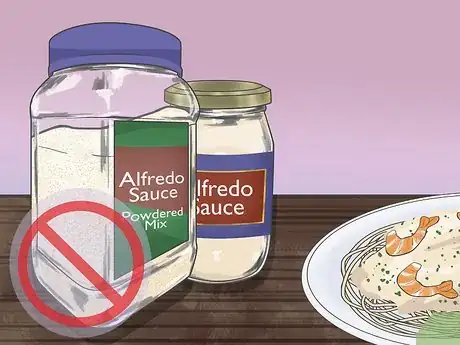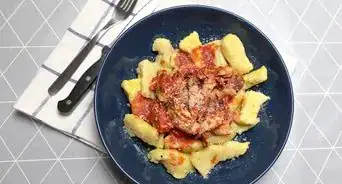This article was co-authored by wikiHow Staff. Our trained team of editors and researchers validate articles for accuracy and comprehensiveness. wikiHow's Content Management Team carefully monitors the work from our editorial staff to ensure that each article is backed by trusted research and meets our high quality standards.
There are 20 references cited in this article, which can be found at the bottom of the page.
This article has been viewed 15,810 times.
Learn more...
You can find pasta anywhere, but there’s nothing like authentic Italian pasta! Italians typically enjoy their pasta al dente (slightly undercooked) because it allows more time for chewing and enjoying the savory flavors of the noodles and sauce. With the proper cooking time and the right sauce pairing, you can enjoy authentic al dente pasta at home. If you’re visiting Italy, you’ll need to know how to eat it when dining out and what not to do to avoid offending the chef. Buon Appetito!
Steps
Dining like an Italian
-
1Avoid using a spoon to twirl your pasta. Real Italians ground their fork on the bottom of the plate to spin longer noodles around the fork. If you’re eating long, thin noodles like spaghetti or angel hair, don’t cut the noodles with a knife or the side of your fork—spin only a few at a time so you can fit it into your mouth.[1]
- If the noodles are served in soup (like orzo or stelline), then it's appropriate to use a spoon.
-
2Don't add cheese if the pasta sauce has fish or seafood. When you envision a fresh plate of pasta with shrimp, salmon, or scallops, it's hard not to think of grating cheese all over it—but doing so isn't authentically Italian. Instead, if the dish has fish or seafood, sprinkle breadcrumbs over the pasta.[2]
- For the most authentic flavor, saute the breadcrumbs in olive oil before sprinkling them onto the pasta.
Advertisement -
3Don't ask for extra cheese if you're dining out. If you're at an authentic Italian restaurant and have received a pasta dish that already has cheese on it, don't ask for more. It's considered insulting to the chef because excessive cheese will overpower the other flavors in the dish.[3]
- Certain cheeses pair well with certain sauces. For instance, use parmigiano-reggiano for creamy sauces, pecorino romano for oil-based sauces, or ricotta for cream-less sauces. However, this isn’t a strict rule because parmigiano will also go on just about anything!
-
4Eat pasta as a first (primi) course by itself. Italians love food so much that pasta isn't even the main event of the meal! To dine like a true Italian, order it as one of your first courses with nothing else—no salad or meatballs.[4]
- In Italy, the course ordering is as follows: appetizers (antipasti like breads, cured meats, and pickled veggies), primi (pasta), secundi (meat dish with salad or veggies), and dolce (dessert).
Serving Pasta the Correct Way
-
1Serve pasta on a plate, not in a bowl. Bowls are for packing in lots of bulk, but since the portion sizes are smaller in Italy, it's more appropriate to serve pasta on a plate. The only exception to this rule is if you’re serving children who might have trouble keeping the pasta on the plate.[5]
- The serving size of pasta dishes in Italy is much smaller—only 4 to 5 ounces (113 to 142 grams). This allows you to enjoy the pasta without getting too full to eat the next 2 courses of your meal!
-
2Don’t put meatballs on the pasta. Spaghetti and meatballs isn’t a true Italian dish. Meatballs are typically eaten as their own meal and are no bigger than a golf ball—much smaller in size than meatballs in America.[6]
- If you still want to enjoy meatballs with your pasta, serve them on the side or afterwards as the secundi (meat) course.
-
3Offer bread only as an appetizer without olive oil and balsamic or butter. You won’t find a slice of garlic bread of focaccia perched on top of your noodles in Italy, nor will it be served with butter or oil and vinegar. Italians serve bread before the pasta course alongside cheeses, cured meats, and pickles.[7]
- Ciabatta, focaccia, friselle, pane di Laterza, and ciambella are all authentic bread varieties to kick off your Italian feast.
-
4Enjoy your authentic Italian meal with water or wine only. Italians of all ages only complement their meals with wine or water—that means no juice, milk, coffee, soda, or cocktails on the table. If you need your coffee fix, sip on a small espresso only after you’ve finished your last bite of dessert (not with your dessert).[8]
- Fizzy water (acqua frizzante) without ice is acceptable if you’d like some bubbles to wash down that delicious pasta.
- If you’re dining with an Italian and they’ve finished their post-meal espresso, don’t offer them another bite to eat—it’s discourteous and socially awkward (akin to offering someone a piece of chocolate right after they’ve brushed their teeth).
Cooking Al Dente Noodles
-
1Make the sauce before you make the noodles. Whether you’re making ragu, bolognese, or a creamy lemon-butter sauce, it needs to be ready by the time you strain the noodles so it can properly stick to them. Noodles that sit around too long without sauce can stick together and form hard mushy lumps.[9]
- Use a large saucepan to make the sauce because you’ll be adding the pasta to it later on.
-
2Add 1 tbsp (15 g) of salt for each pound (454 g) of noodles you're cooking. Salt helps add flavor to the noodles, so don't be skimpy! Use a liberal amount of table, sea salt, or kosher salt but not so much that you're cooking the noodles in ocean water. For instance, if you're cooking 16 oz (454 g) of noodles, you'll use 169 fluid ounces (5,000 mL) of water and 10.5 tsp (52 g) of salt.[10]
- Do not pour olive oil into the water—it will only prevent the sauce from sticking to the noodles later on.
- Kosher salt is less dense than table or sea salt, so use 1.5 tablespoon (22.2 ml) (19 g) of kosher salt for every 16 oz (454 g) of pasta.
-
3Don’t break long noodles like angel hair before adding them to boiling water. It may seem easier to work with shorter noodles, but breaking them up is a big no-no in Italy! insert them vertically, holding them until the bases have softened and you can push the top of the noodles down into the water.[11]
- The water should be fully boiling before you add the noodles so they don’t get mushy and lose their structure.
-
4Stir long, stringy noodles with a fork every minute or so as they boil. Use a fork to stir the noodles as they boil to help break up any pieces that are stuck together. It will also give you an idea of how much longer you need to cook them.[12]
- Al dente noodles will bend over the fork as you lift it out of the water but still hold a structured bend (that is, it won't bend so much that it's flat against either side of the fork).
- If you’re cooking shells, twists, or stuffed varieties, use a spoon for stirring so you don’t puncture them.
-
5Check if the noodles are al dente 3 minutes before the suggested cooking time. Use a fork to dip down into the noodles once they’re mostly through the recommended cooking time (or when you notice they're softening) and taste one of the noodles. If the noodles are soft yet still slightly firm and chewy, they’re perfect! For tube-shaped noodles, look for a thin white ring around the inside. For stringy noodles, look for a white dot in the center when you bite through one end.[13]
- If the noodles are mushy, they're overcooked. You can still eat them but it won't have an authentic al dente Italian taste.
- If it has a slight crunch to it, let them cook for 20 seconds longer before taste-testing again.
- You can’t un-cook noodles, so when in doubt, it’s best to take them out sooner rather than later.
-
6Drain the noodles into a colander placed in the sink, leaving some of the water. Place a colander in the sink and pour the noodles and cooking water into it to drain out most of the liquid. Leave a little bit of the cooking water in the pot with some of the noodles to provide a starchy-salty taste.[14]
- As an alternative, spoon 2 spoonfuls of cooking water into the sauce before pouring all of the noodles into the colander.
- Do not rinse them under water because doing so removes the starch, making it harder for the sauce to stick to the noodles.
-
7Transfer the noodles into the sauce and cook them for 1 to 2 minutes longer. Pour the drained nearly-cooked noodles into the skillet or saucepan containing the sauce and stir them together. Let them cook over medium heat for 1 or 2 more minutes, taste testing every 20 seconds for the perfect al dente texture.[15]
- When you bite into a noodle, you should see a thin white ring on the noodle and notice a chalky, chewy texture.
Pairing Noodles and Sauces Correctly
-
1Use a cream or oil-based sauce for long, skinny noodles. Spaghetti, linguine, fusilli, and vermicelli need creamy, oil-based sauce so it will stick to the shaft of the noodle. A light seafood-based sauce is also a great, authentic option.[16]
- Avoid using chunky sauces on long, skinny noodles because they won’t be able to support the weight of the chunks.
-
2Pair long, ribbon-like noodles with meaty, rich sauces. A hearty bolognese sauce is perfect for noodles like fettuccine, pappardelle, tagliatelle, and mafaldine. The strands have enough body to carry the small to medium-sized chunks.[17]
- As a vegetarian alternative, use faux-ground beef crumbles made from seitan or tempeh.
-
3Enjoy twist-shaped noodles with light, smooth sauces. Pesto genovese is the perfect companion to twisty varieties like fusilli, trofie, gemelli, or strozzapreti. You can also use a smooth marinara or puttanesca sauce (if you like spice).[18]
- Feel free to add a small amount of sun-dried tomatoes or roasted zucchini to add some extra flavor and texture.
-
4Adorn tube-shaped noodles with hearty vegetable-based sauces. A thick, chunky bolognese or ragu sauce will taste great with penne, rigatoni, macaroni, or paccheri noodles. The noodles can stand up to large chunks in the sauce, so don't be bashful if you want to add steamed veggies or use a hearty vegetable sauce.[19]
- Get creative and make a sauce with roasted eggplant or butternut squash. It may not be as authentic as a tomato-based sauce, but you can always add authentic Italian spices like oregano, basil, parsley, and rosemary.
-
5Dress filled noodles with light oil or butter-based sauce. When it comes to stuffed noodles like ravioli and cappelletti, the flavor inside the dough should be the star! Avoid overwhelming those subtle savory bites by drizzling the cooked noodles with olive oil or melted butter infused with garlic, cracked pepper, oregano, basil, or red pepper.[20]
- To infuse oil or butter, heat it up on the stove with whatever herbs and spices you like (oregano, rosemary, basil, and parsley are authentic Italian options). Let it heat up to just under a simmer and then keep it at medium heat until you add the noodles for the last minute or so of cooking.
-
6Serve orzo and tortellini in a light broth with parmesan. Tortellini and Alfredo sauce is a popular dish but it's not authentic at all. Both orzo and tortellini are traditionally served in a broth made from chicken or vegetable stock. Add parsley, black pepper, and freshly grated parmesan cheese to complement the soft, delicate flavor of the noodles.[21]
- Orzo is also a great option to eat in soups like Italian wedding soup.
-
7Avoid using Alfredo sauce from a jar, can, or powdered packet. You can order pasta Alfredo in Italy—it's just not made with any creamy white sauce from a jar. Authentic Italian chefs make pasta Alfredo by melting butter in a pan on low heat, pouring in some cream, and adding the almost-cooked noodles to cook for the last 1 to 2 minutes. The butter and cream get absorbed by the pasta, creating a creamy dressing—much better than anything you'll find in a jar![22]
- If you're making pasta Alfredo at home, spoon 2 spoonfuls of the cooking water into a saucepan with butter and cream. Drain the noodles 1 to 2 minutes before they're done and let the butter and cream do the rest.
Warnings
- If you’re visiting Italy, don’t expect authentic restaurants to open for dinner until 7:30 or 8:00 PM. Some places only are open for lunch between noon and 1:00 PM, so plan accordingly.⧼thumbs_response⧽
References
- ↑ https://youtu.be/QW0rtRKy1l0?t=2
- ↑ https://youtu.be/QW0rtRKy1l0?t=41
- ↑ https://youtu.be/QW0rtRKy1l0?t=60
- ↑ https://youtu.be/QW0rtRKy1l0?t=76
- ↑ https://www.mashed.com/30509/eat-spaghetti-like-true-italian/
- ↑ https://www.smithsonianmag.com/arts-culture/is-spaghetti-and-meatballs-italian-94819690/
- ↑ https://thefoodellers.com/en/eating-in-italy-the-10-unforgettable-rules-to-be-like-an-italian
- ↑ http://tuscantraveler.com/2012/florence/food-rule-italian-wine-water-beer/
- ↑ https://www.smithsonianmag.com/arts-culture/youre-doing-it-wrong-the-guide-to-making-perfect-pasta-946855/
- ↑ https://youtu.be/o14A4Iimlkg?t=20
- ↑ https://youtu.be/o14A4Iimlkg?t=31
- ↑ https://youtu.be/o14A4Iimlkg?t=40
- ↑ https://youtu.be/o14A4Iimlkg?t=64
- ↑ https://youtu.be/ZCFCWg-BX7M?t=94
- ↑ https://www.bonappetit.com/story/al-dente-pasta-is-actually-overcooked
- ↑ https://www.splendidtable.org/story/you-are-probably-doing-it-wrong-how-to-eat-pasta-like-an-italian
- ↑ https://www.splendidtable.org/story/you-are-probably-doing-it-wrong-how-to-eat-pasta-like-an-italian
- ↑ https://www.delish.com/cooking/g26990388/best-sauce-for-pasta-type/
- ↑ https://www.splendidtable.org/story/you-are-probably-doing-it-wrong-how-to-eat-pasta-like-an-italian
- ↑ https://www.bbcgoodfood.com/howto/guide/perfect-pairings-how-match-pasta-shapes-sauces
- ↑ https://www.splendidtable.org/story/you-are-probably-doing-it-wrong-how-to-eat-pasta-like-an-italian
- ↑ https://youtu.be/QW0rtRKy1l0?t=139
- ↑ https://www.italianfoodexcellence.com/how-to-recognize-a-good-pasta/
- ↑ https://www.smithsonianmag.com/arts-culture/youre-doing-it-wrong-the-guide-to-making-perfect-pasta-946855/
